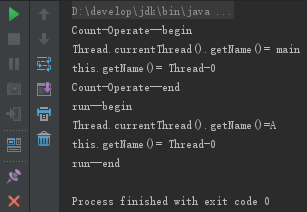currentThread()方法可以返回段正在被哪个线程调用的信息。
示例代码:
public class Main {
public static void main(String[] args) {
System.out.println(Thread.currentThread().getName());
}
}
结果:说明main()被名为main的线程调用。

示例代码:
public class OneThread extends Thread {
public OneThread() {
System.out.println("构造方法的打印: " + Thread.currentThread().getName());
}
@Override
public void run() {
System.out.println("run方法的打印:" + Thread.currentThread().getName());
}
}
执行方法:
public class Main {
public static void main(String[] args) {
OneThread ot = new OneThread();
ot.start();
}
}
结果:

若执行方法为:
public class Main {
public static void main(String[] args) {
OneThread ot = new OneThread();
ot.run();//注意此处调用的是run(),我们曾提过,调用run()相当于将run()交给其他线程来完成
}
}
结果:

更复杂的示例:
public class TwoThread extends Thread {
public TwoThread() {
System.out.println("Count-Operate--begin");
System.out.println("Thread.currentThread().getName()= " + Thread.currentThread().getName());
System.out.println("this.getName()= " + this.getName());
System.out.println("Count-Operate--end");
}
@Override
public void run() {
System.out.println("run--begin");
System.out.println("Thread.currentThread().getName()=" + Thread.currentThread().getName());
System.out.println("this.getName()= " + this.getName());
System.out.println("run--end");
}
}
执行代码:
public class Main {
public static void main(String[] args) {
TwoThread tt = new TwoThread();
Thread t = new Thread(tt);
t.setName("A");
t.start();
}
}
结果:

根据结果逆向分析:Thread.currentThread().getName()获得的始终是主线程(也就是说由JVM创建的main线程)。
而由对象本身调用的getName()获取的都是打开的第二个线程Thread-0,也就是执行start()方法的线程。
现在分析发现这个思考是有问题的。
Thread.currentThread().getName()获得的始终是执行start()方法的线程(或者说是调用run()方法的线程)。
而this.getName()获得的都是run()方法所在线程对象的名称。
源码地址:https://github.com/lilinzhiyu/threadLearning